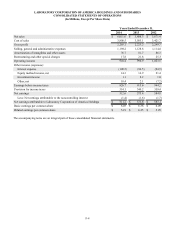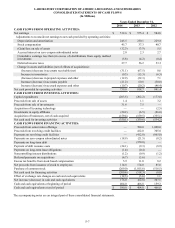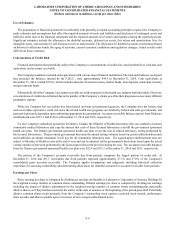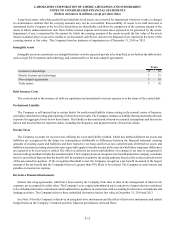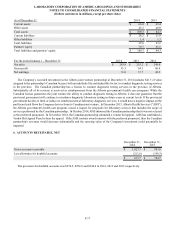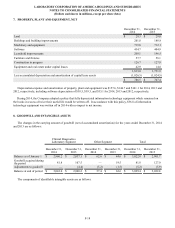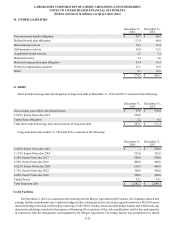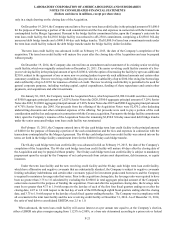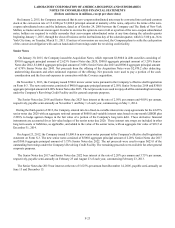LabCorp 2014 Annual Report Download - page 92
Download and view the complete annual report
Please find page 92 of the 2014 LabCorp annual report below. You can navigate through the pages in the report by either clicking on the pages listed below, or by using the keyword search tool below to find specific information within the annual report.F-13
Fair Value of Financial Instruments
Fair value measurements for financial assets and liabilities are determined based on the assumptions that a market participant
would use in pricing an asset or liability. A three-tiered fair value hierarchy draws distinctions between market participant
assumptions based on (i) observable inputs such as quoted prices in active markets (Level 1), (ii) inputs other than quoted prices
in active markets that are observable either directly or indirectly (Level 2) and (iii) unobservable inputs that require the Company
to use present value and other valuation techniques in the determination of fair value (Level 3).
Research and Development
The Company expenses research and development costs as incurred.
New Accounting Pronouncements
In February 2013, the FASB issued a new accounting standard on joint and several liability arrangements for which the total
amount of the obligation is fixed at the reporting date. Under this new standard, obligations resulting from joint and several
liability arrangements are to be measured as the sum of: (a) the amount the reporting entity agreed with its co-obligors that it will
pay and (b) any additional amount the reporting entity expects to pay on behalf of its co-obligors. This standard, which applies
prospectively, became effective for the Company beginning January 1, 2014. The adoption of this standard did not have a material
effect on the consolidated financial statements.
In March 2013, the FASB issued a new accounting standard on foreign currency matters that clarifies the guidance of a parent
company's accounting for the cumulative translation adjustment upon derecognition of certain subsidiaries or groups of assets
within a foreign entity or of an investment in a foreign entity. Under this new standard, a parent company that ceases to have a
controlling financial interest in a foreign subsidiary or group of assets within a foreign entity shall release any related cumulative
translation adjustment into net income only if a sale or transfer results in complete or substantially complete liquidation of the
foreign entity. This standard, which applies prospectively, became effective for the Company beginning January 1, 2014. The
adoption of this standard did not have a material effect on the consolidated financial statements.
In April 2014, the FASB issued a new accounting standard on discontinued operations that significantly changes criteria for
discontinued operations and disclosures for disposals. Under this new standard, to be a discontinued operation, a component or
group of components must represent a strategic shift that has (or will have) a major effect on an entity's operations and financial
results. Expanded disclosures for discontinued operations include more details about earnings and balance sheet accounts, total
operating and investing cash flows, and cash flows resulting from continuing involvement. The guidance is to be applied
prospectively to all new disposals of components and new classifications as held for sale beginning in 2015, with early adoption
allowed in 2014. The adoption of this standard is not expected to have a material impact on the consolidated financial statements.
In May 2014, the FASB issued the converged standard on revenue recognition with the objective of providing a single,
comprehensive model for all contracts with customers to improve comparability in the financial statements of companies reporting
using International Financial Reporting Standards and U.S. Generally Accepted Accounting Principles. The standard contains
principles that an entity must apply to determine the measurement of revenue and timing of when it is recognized. The underlying
principle is that an entity must recognize revenue to depict the transfer of goods or services to customers at an amount that the
entity expects to be entitled to in exchange for those goods or services. An entity can apply the revenue standard retrospectively
to each prior reporting period presented (full retrospective method) or retrospectively with the cumulative effect of initially applying
the standard recognized at the date of initial application in retained earnings. The revenue standard is effective for the Company
beginning January 1, 2017. The Company is currently evaluating the expected impact of the standard.
In August 2014, the FASB issued a new accounting standard that explicitly requires management to assess an entity's ability
to continue as a going concern, and to provide related financial statement footnote disclosures in certain circumstances. Under
this standard, in connection with each annual and interim period, management must assess whether there is substantial doubt about
an entity's ability to continue as a going concern within one year after the financial statements are issued (or available to be issued
when applicable). Management shall consider relevant conditions and events that are known and reasonably knowable at such
issuance date. Substantial doubt about an entity's ability to continue as a going concern exists if it is probable that the entity will
be unable to meet its obligations as they become due within one year after issuance date. Disclosures will be required if conditions
or events give rise to substantial doubt. This standard is effective for the Company for the annual period after December 15, 2016,
LABORATORY CORPORATION OF AMERICA HOLDINGS AND SUBSIDIARIES
NOTES TO CONSOLIDATED FINANCIAL STATEMENTS
(Dollars and shares in millions, except per share data)



